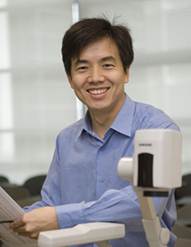应胡劲松研究员邀请,新加坡南洋理工大学熊启华教授来我室交流。
Semiconductor Laser Cooling and Nanolasers
Qihua Xiong
Nanyang Associate Professor and Fellow of Singapore National Research Foundation
School of Physical and Mathematical Sciences,
Nanyang Technological University
Email Address: Qihua@ntu.edu.sg.
报告时间:2月28日 周五 上午9:00
地点:化学所5号楼100
Optical irradiation accompanied by spontaneous anti-Stokes emission can lead to cooling of matter, a phenomenon known as laser cooling or optical refrigeration proposed in 1929 by Peter Pringsheim. In solid state materials, the cooling is achieved by annihilation of lattice vibrations (i.e., phonons). Since the first experimental demonstration in rare-earth doped glasses, considerable progress has been made particularly in ytterbium-doped glasses or crystals with a recent record of ~110 K cooling from ambient. On the other hand, it would be more tantalizing to realize laser cooling in direct band-gap semiconductors. Semiconductors exhibit more efficient pump light absorption, much lower achievable cooling temperature and direct integrability into electronic and photonic devices. However, so far no net-cooling in semiconductors has been achieved despite of many experimental and theoretical efforts in the past few decades. In the first part of the presentation, we demonstrate the first net laser cooling in semiconductors using cadmium sulfide (CdS) nanobelt. Under a low power excitation, we have achieved a ~40 K and ~20 K net cooling in CdS nanobelts starting from 290 K pumped by 514 nm and 532 nm lasers, respectively. Our findings suggest alternative II-VI semiconductors for laser cooling and may find promising applications in the field of cryogenics with the advantage of compactness, vibration- and cryogen-free, high reliability and direct integrability into nanoscale electronic and photonic devices. The second part of the talk will present our recent progress in tunable photonic and plasmonic nanolasers using semiconductor nanowires. We will demonstrate the first room-temperature ultra-violet (~370 nm) plasmonic nanolaser with an extremely-low-threshold (~3.5 MW/cm2) bases on triagonal-shape GaN nanowires. A closed-contact planar semiconductor-insulator-metal interface greatly lessens the extrinsic cavity loss, and efficiently promotes the exciton-plasmon energy transfer thus furnishes adequate optical gain to compensate the loss.

Biography: Qihua Xiong received his B.S. degree in physics from Wuhan University in 1997, and then finished three years graduate studies at Shanghai Institute of Applied Physics, Chinese Academy of Sciences. He went to the United States in 2000 and received a Ph.D. degree under the supervision of Prof. Peter C. Eklund from The Pennsylvania State University in 2006. After three years postdoctoral experience in Prof. Charles M. Lieber’s group at Harvard University, he joined Nanyang Technological University as an assistant professor in 2009. He is a Fellow of Singapore National Research Foundation awarded in 2009. He was recently promoted as Nanyang Associate Professor and awarded the prestigious Nanyang Award for research excellence. Prof. Xiong’s research focuses electrical and optical properties of semiconductor nanomaterials. He recently ventured into the field of 2D layered materials and laser cooling of semiconductors.

